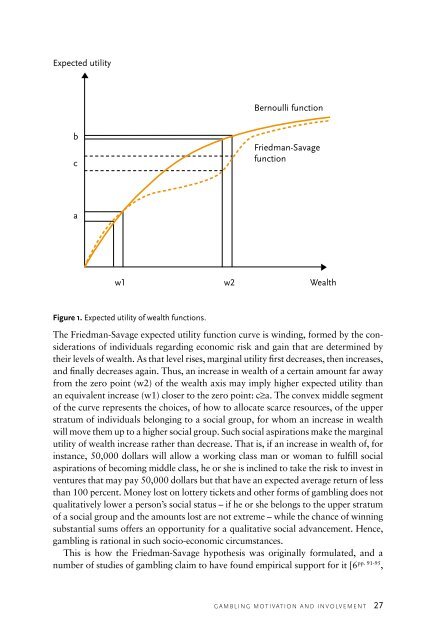Gambling motivation and involvement: A review of social
Gambling motivation and involvement: A review of social
Gambling motivation and involvement: A review of social
Create successful ePaper yourself
Turn your PDF publications into a flip-book with our unique Google optimized e-Paper software.
Expected utility<br />
b<br />
c<br />
a<br />
w1<br />
figure 1. Expected utility <strong>of</strong> wealth functions.<br />
w2<br />
Bernoulli function<br />
Friedman-Savage<br />
function<br />
Wealth<br />
The Friedman-Savage expected utility function curve is winding, formed by the considerations<br />
<strong>of</strong> individuals regarding economic risk <strong>and</strong> gain that are determined by<br />
their levels <strong>of</strong> wealth. As that level rises, marginal utility first decreases, then increases,<br />
<strong>and</strong> finally decreases again. Thus, an increase in wealth <strong>of</strong> a certain amount far away<br />
from the zero point (w2) <strong>of</strong> the wealth axis may imply higher expected utility than<br />
an equivalent increase (w1) closer to the zero point: c≥a. The convex middle segment<br />
<strong>of</strong> the curve represents the choices, <strong>of</strong> how to allocate scarce resources, <strong>of</strong> the upper<br />
stratum <strong>of</strong> individuals belonging to a <strong>social</strong> group, for whom an increase in wealth<br />
will move them up to a higher <strong>social</strong> group. Such <strong>social</strong> aspirations make the marginal<br />
utility <strong>of</strong> wealth increase rather than decrease. That is, if an increase in wealth <strong>of</strong>, for<br />
instance, 50,000 dollars will allow a working class man or woman to fulfill <strong>social</strong><br />
aspirations <strong>of</strong> becoming middle class, he or she is inclined to take the risk to invest in<br />
ventures that may pay 50,000 dollars but that have an expected average return <strong>of</strong> less<br />
than 100 percent. Money lost on lottery tickets <strong>and</strong> other forms <strong>of</strong> gambling does not<br />
qualitatively lower a person’s <strong>social</strong> status – if he or she belongs to the upper stratum<br />
<strong>of</strong> a <strong>social</strong> group <strong>and</strong> the amounts lost are not extreme – while the chance <strong>of</strong> winning<br />
substantial sums <strong>of</strong>fers an opportunity for a qualitative <strong>social</strong> advancement. Hence,<br />
gambling is rational in such socio-economic circumstances.<br />
This is how the Friedman-Savage hypothesis was originally formulated, <strong>and</strong> a<br />
number <strong>of</strong> studies <strong>of</strong> gambling claim to have found empirical support for it [6 pp. 91-95 ,<br />
G A M B L I N G M O T I VAT I O N A N D I N V O LV E M E N T 27

















